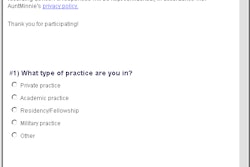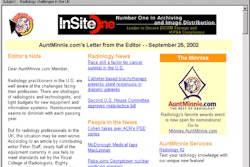NEW ORLEANS - Maintaining staff competency, assessing patients in a timely fashion, and keeping written records may seem like the most rudimentary elements of running a medical facility. Yet many hospitals fail to meet even these requirements when they're under the scrutiny of the Joint Commission on Accreditation of Healthcare Organizations (JCAHO), according to a presenter Tuesday at the American Healthcare Radiology Administrators (AHRA) meeting.
"One of the most important things when getting ready for a survey is to know what the top troublesome standards were for the previous year," explained Chicago-based consultant Ginger Whitlock, who served as an associate director of the ambulatory accreditation program at JCAHO until May 2002. "There is nothing magical about the joint commission review. You just have to be able to explain to the surveyor why you do what you do," she said.
Speaking to an audience of mainly hospital-based radiology administrators, Whitlock outlined the top 11 JCAHO standards that have historically proven the trickiest for institutions:
- Assessing, maintaining, and improving staff competency (HR.3). "Get your staff verbalizing about what they do every day. (In a JCAHO survey), you are telling your story to (a surveyor) whom you don’t know. They are going to ask you questions. We need to practice talking about our jobs," Whitlock said.
- Accepting and transcribing verbal orders (IM.7.7). "You are in the field, where things are verbalized, and maybe it doesn’t get written down in a timely manner," Whitlock said. But the standard is clear. Whenever an order is given, it must be written down within whatever time frame has been established for doing so. In turn, the person who took the order must be able to demonstrate that it was carried out, based on the time frame required under state law, she said.
- Preparing and dispensing medications (TX.3.5). For imaging, the storage of contrast media is the main issue. "The joint commission considers it a medication," she said. "We’re still finding contrast medium just sitting around." Contrast must be kept under lock and key, Whitlock said, and in many cases locking it up inside the facility isn't sufficient either, especially if an outside agency such as a janitorial service will be coming in during off-hours.
- Completing history, physical, and other patient assessment within 24 hours (PE.1.7.1). This standard is applicable when a patient is being given conscious sedation or anesthesia by the imaging department, Whitlock said. Interdepartmental communication is another thing surveyors monitor carefully.
"Make sure everyone has got the same answer to the same question. That’s what bites us on surveys sometimes. They do ask the same questions over and over again. They want to see and hear consistency," she said.
- Completing and recording appropriate entries in medical records before the JCAHO survey (PE 1.8).
- Entering progress notes immediately (IM.7.3.2.2). Comments on postsurgical patients must be entered into their records at once; waiting on the longer formal report won’t sit well with the JCAHO surveyor, Whitlock said.
- Appointing, reappointing, and clinical privileges of medical staff (MS.5.11). "The main thing to remember is that if you are working with a radiologist or neurologist and they start doing some new and different (procedure), you might want to make sure that they’ve been privileged to do it," Whitlock said. Sometimes physicians are trained to perform a new procedure, but forget to tell the medical secretary. It can be especially problematic in off-site imaging centers or multisite facilities, where hospital privileges may not apply.
- Providing durable, legible copies of patient history and physical (PE.1.7.1.1).
- Assessing functional status (PE.1.3).
- Assessing pain in all patients (PE.1.4). While imaging may not be directly treating the patient’s pain, pain-level assessments still need to take place, especially after an imaging procedure, and this information should be documented.
The healthcare provider defines when and how pain is assessed in patients. The facility should have a policy that defines how pain is assessed, using whatever skills or tools it deems appropriate. The key is to develop a policy and stick with it, Whitlock said.
"Guess what generates the most Type One recommendations on a survey? That you are not following your own policy," she added.
- Providing presedation or preanesthesia assessment (PE.1.8.1). Whitlock emphasized that the first five areas are what surveyors look for during random, unannounced JCAHO reviews. She urged the audience to visit the JCAHO Web site on a regular basis, even if their facility is not up for review. She said imaging professionals must make the extra effort with surveyors to talk about their work.
"The field of imaging and diagnostic radiology needs to be asking them more questions," she said. "Often times, the joint commission surveyor doesn’t understand what you do and how the standards apply to that, so often times, you’ll find yourself doing some educating of the surveyor."
By Shalmali Pal
AuntMinnie.com staff writer
July 31, 2002
Related Reading
Group ties accreditation to patient safety, July 25, 2002
Copyright © 2002 AuntMinnie.com



















